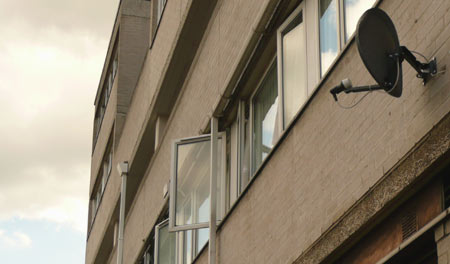
Review: Katyal, N. K. “Architecture as Crime Control”, Yale Law Journal, March 2002, Vol 111, Issue 5.
Professor Neal Kumar Katyal of Georgetown University Law School, best-known for being (successful) lead counsel in the Hamdan v. Rumsfeld case dealing with Guantanamo Bay detainees, has also done some important work on the use of design as a method of law enforcement in both the digital and built environments.
This article, ‘Architecture as Crime Control’, specifically addresses itself to a legal and social policy-maker audience in terms of the areas of focus and the arguments used, but is also very relevant to architects and designers open to being enlightened about the strategic value of their work. Specifically with regard to ‘architectures of control’ and ‘design for behaviour change’, as one might expect, there are many useful examples and a great deal of interesting analysis. In this review, I will try to concentrate on examples and design techniques given in the article, along with some of the thinking behind them – the most useful aspects from the point of view of my own research – rather than attempting to analyse the legal and sociological framework into which all of this fits.
Katyal starts by acknowledging how the “emerging field of cyberlaw, associated most directly with Lawrence Lessig” has brought the idea of ‘code’ constraining behaviour to a level of greater awareness, but suggests that the greater permanence and endurance of architectural changes in the real world – the built environment – may actually give greater potential for behaviour control, as opposed to the “infinitely malleable” architecture of cyberspace:
It is time to reverse-engineer cyberlaw’s insights, and to assess methodically whether changes to the architecture of our streets and buildings can reduce criminal activity.
A theme to which Katyal returns throughout the article is that the policy response to James Wilson and George Kelling’s influential ‘Broken Windows’ – “an architectural problem in crime control” – has largely been a law enforcement one (“prosecution of minor offenses like vandalism in an attempt to deter these ‘gateway crimes'”) instead of actual architectural responses, which, Katyal argues, could have a significant and useful role in this field.
Design principles
Before tackling specific architectural strategies, Katyal discusses the general area of using “design principles” to “influence, in subtle ways, the paths by which we live and think” – a great summary of many of the techniques we’ve considered on this blog over the last couple of years, though not all have been subtle – and gives some good examples:
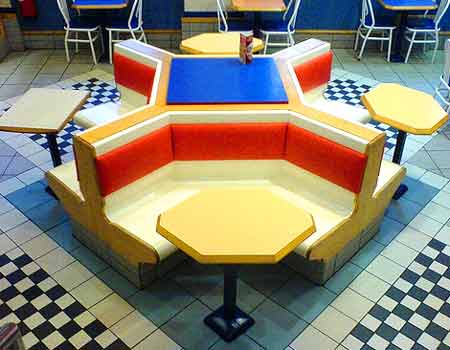
Fast food restaurants use hard chairs that quickly grow uncomfortable so that customers rapidly turn over
Image from Headphonaught’s Flickr stream
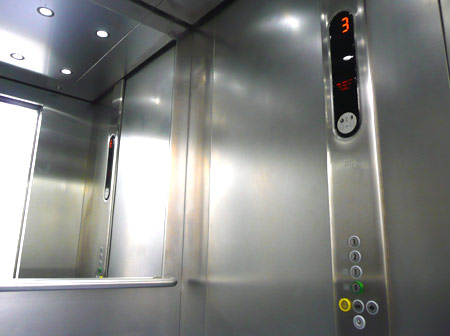
Elevator designers place the numerals and floor indicator lights over people’s heads so that they avoid eye contact and feel less crowded
Supermarkets have narrow aisles so that customers cannot easily talk to each other and must focus on the products instead
(We’ve also seen the opposite effect cited, i.e. using wider aisles to cause customers to spend longer in a particular aisle – clearly, both effects could be employed in different product areas within the same supermarket, to suit whatever strategy the retailer has. There are plenty of other tricks too.)
And, in a footnote, Katyal cites Personal Space by Robert Sommer, which provides:
other examples, such as a café that hired an architect to design a chair that placed “disagreeable pressure on the spine if occupied for over a few minutes” and Conrad Hilton’s decision to move couches out of hotel lobbies to minimise the number of lingering visitors.
(Sommer’s work sounds interesting and relevant, and I look forward to investigating it*)
As Katyal puts it, “with strategies like these, private architects are currently engaging in social control.”
Moving on to architectural strategies for crime control, Katyal expounds four ‘mechanisms’ identified in the field of Crime Prevention Through Environmental Design (CPTED):
Design should:
(1) Create opportunities for natrual surveillance by residents, neighbors and bystanders; (2) Instill a sense of territoriality so that residents develop proprietary attitudes and outsiders feel deterred from entering a private space; (3) Build communities and avoid social isolation; (4) Protect targets of crime.
Before expanding on the practical and legal application of each of these mechanisms, Katyal makes the point that while they can often “work in synergy… natural surveillance is most effective when social isolation is minimized and when design delays the perpetration of crime,” there can be conflicts and any strategy needs to be developed within the context of the community in which it is going to be applied:
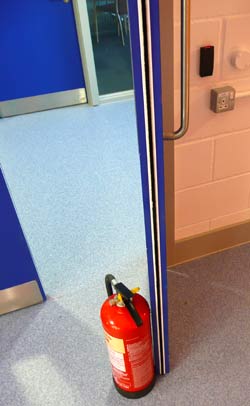
Effective design requires input by the community. Without such input, security features are likely to be resented, taken down or evaded (consider the ‘security’ doors propped open on campuses today.
(This issue of ‘resentment’ or even ‘inconvenience’ is, I feel, going to be a significant factor in my own studies of environmentally beneficial behaviour-changing products; we shall see.)
Natural surveillance
The idea of natural surveillance is to create situations where areas are overlooked by neighbours, other residents and so on, with the effect being both a crime deterrent (if the criminal knows he is being watched, or might be watched, he may decide against the crime) and to improve the effectiveness of solving the crime afterwards (someone will have seen what happened). Katyal cites Jane Jacobs‘ argument that diversity of use can be an important way of bringing about natural surveillance – preferably with different activities occurring throughout the day, to ensure that there is always a population there to keep any eye on things. However, short of this kind of deliberate diversity planning, there are specific techniques that can be used on individual buildings and their surroundings to increase natrual surveillance; Katyal suggests the addition of windows facing onto public spaces, ensuring sight lines down corridors and alleyways, positioning windows so that neighbours can watch each other’s houses, bringing parking areas in front of stores rather than out of sight behind them, and making sure hallways and lobbies are clearly visible to passers-by. He gives the example of redesigning the layout of a school’s grounds to increase the opportunity for natural surveillance:
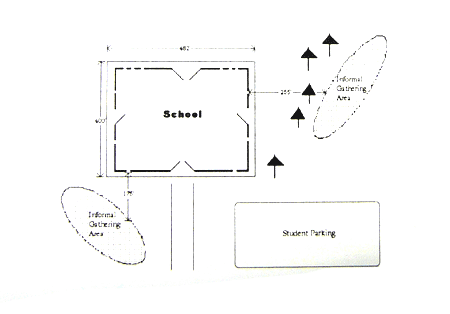
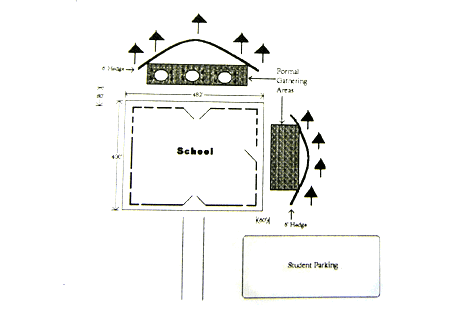
Images from Katyal, N. K. “Architecture as Crime Control”, Yale Law Journal, March 2002, Vol 111, Issue 5.
[In the first image] the informal areas are blocked form sight and far from school grounds. Because no central place for congregation exists, students are spread over the grounds, and there is insufficient density for monitoring. The four open entrances and exits facilitate access to the school and escape.
…
[In the second image,] through the designation of formal gathering areas, other places become subtly off-limits to students. Indeed, those who are present in such areas are likely to attract suspicion…. the formal gathering areas are naturally surveilled by building users… [and] are long and thin, running alongside the school windows, and two hedges prevent students from going fuarther away. Moreover, the west entrance, which had the least potential for surveillance, has been closed…
Lighting can also be a major method of increasing natural surveillance:
First, it helps anyone viewing a situation to see it more clearly and thereby deters some crimes by increasing the powers of perception of those watching. Second, it encourages people to be in the area in the first place because the greater visibility creates a sense of security. The more eyes on the street, the more visibility constrains crime.
(Incidentally, Katyal comments – having interviewed an architect – that the use of yellow street lighting “can increase the crime rate by making streets (and individuals on them) look menacing”, hence a tendency for some urban developers to move to white lighting instead.)
Territoriality
Territoriality – also much of the focus of defensible space (which I’ll discuss in a later post) – “both provides an incentive for residents to take care of and monitor an area and subtly deters offenders by warning them that they are about to enter a private space.” Some of Katyal’s examples are wonderfully simple:
Monuments and markers can also demarcate the transition from public space into private space… A study of burglaries in Salt Lake City… revealed that houses with nameplates had lower rates of intrusion than those without them.
One rather simple way is to place two buildings in an ‘L’ formation with a fence that completes the triangle. Children can play in the open space, and adults can look out of their windows at their children.
In the first, a series of buildings lacks a common entrance, and pedestrians cut through the property. The addition of a simple overhead arch, however, creates a sense of private space:
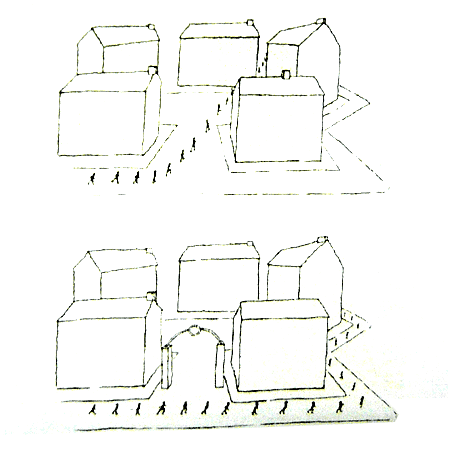
Images originally from Stollard, P. Crime Prevention Through Housing Design and included in Katyal’s article.
Building community
The third main mechanism, building community, is also heavily interlinked with the idea of defensible space. The aim here is to encourage a sense of community, by creating spaces which cause people to interact, or even reducing the number of dwellings in each individual set so that people are more likely to recognise and come to know their neighbours – something many architects have instinctively tried to do anyway over the past 20 years or so, though not always explicitly with crime reduction in mind:
…even the placement of seats and benches can bring people together or divide them, creating what architects call, respectively, sociopetal and sociofugal spaces. Some architects self-consciously create sociofugal spaces by, for example, designing chairs in airports that make it difficult for people to talk to each other.
Practically, ‘building community’ would necessarily appear to be slightly more nebulous than some of the other mechanisms, but even techniques such as encouraging people to spend more time in communal areas such as a laundry (and hence potentially interact more) can be important here.
Strengthening targets
There are a number of simple examples of target hardening or strengthening given:
Placing deadbolts lower on door frames
(presumably to make kicking them open more difficult)
Having doors in vulnerable locations swing outward
Raising fire escapes to put them out of easy reach
Reducing the size of letter-box openings
If a robber can stand on top of a trash bin and reach a second-floor window, the bin should be placed far from the window
Prickly shrubs placed outside of windows can also deter crime
A duct that spews hot air can be placed near a ground-floor window to deter entry
Smells can also be strategically harnessed either to induce people to come outside or keep them away
The FBI building is built on stilts to minimize damage in the event of a bomb detonation at street level
To decrease the likelihood of presidential assassination, a stretch of Pennsylvania Avenue in front of the White House was barricaded and closed to car traffic
Interestingly, Katyal makes the point that where potential crime targets can be strengthened without making it overly obvious that this has been done, the benefits may be greater:
Modern technology permits targets to be hardened in ways that are not obvious to the public. Strong plastics, graffiti-resistant paint, and doors with steel cores are a few examples. These allow architects to disguise their efforts at strengthening targets and thus avoid sending a message that crime is rampant.
…
Some forms of target hardening are suboptimal in that visibility evinces a fear of crime that can cause damage to the fabric of a community and even increase crime rates.
He again later returns to this point:
Subtle architecture that gently reinfoces law-abiding norms and prevents a degree of intrusion is to be preferred to explicit and awkward physical barricades that reflect the feeling that a community is under siege. Cheap wire fences do not express a belief in the power of law or norms; rather, they reflect the opposite. The same can be said for ugly iron bars on windows, which express the terror of crime as powerfully as does any sign or published crime statistic.
…
A whole host of architectural strategies – such as the placement of doors and windows, creation of semipublic congregation spaces, street layout alterations, park redesign, and many more – sidestep creating an architecture dominated by the expression of fear. Indeed, cheap barricades often substitute for these subtler measures. Viewed this way, gated communities are a byproduct of public disregard of architecture, not a sustainable solution to crime.[my emphasis]
(This last point is especially interesting to me – I must admit I am fascinated by the phenomenon of gated communities and what effect they have on their inhabitants as well as on the surrounding area, both in a Ballardian sense (Running Wild, Cocaine Nights, Super-Cannes) and, more prosaically, in terms of what this voluntary separation does to the community outside the gates. See also the quote from architect John Thompson in my forthcoming post reporting what’s happening at the former Brunel Runnymede Campus)
Other aspects
One point to which Katyal repeatedly returns is – a corollary of the above – the concept of architectural solutions as entities which subtly reinforce or embody norms (desirable ones, from the point of view of law enforcement) rather than necessarily enforce them in totality:
Even the best social codes are quite useless if it is impossible to observe whether people comply with them. Architecture, by facilitating interaction and monitoring by members of a community, permits social norms to have greater impact. In this way, the power of architecture to influence social norms can even eclipse that of law, for law faces obvious difficulties when it attempts to regulate social interaction directly.
…
Architecture can prevent crimes even when criminals believe the probability of enforcement is low… one feature of social norms strategies is that they are often self-enforcing.
I think this is a crucial point, and is applicable in other ‘architectures of control’ techniques outside of the built environment and the specific issues of crime. Norms can be extremely powerful influencers of behaviour, and – to take my current research on changing user behaviour to reduce environmental impact – the ability to design a desirable norm into a product or system, without taking away the user’s sense of ownership of, and confidence in, the product, may well turn out to be the crux of the matter.
As (I hope) will be clear, much of Katyal’s analysis seems applicable to other areas of ‘Design for/against X’ where human factors are involved – not just design against crime. So, for example, here Katyal is touching on something close to the concepts of perceived affordances (and disaffordances) in interaction design:
Psychological evidence shows that criminals decode environmental ‘cues’ to assess the likelihood of success of a given criminal act… the design of a meeting table influences who will speak and when, and who is perceived to have a positionof authority. It is therefore no great shock that the eight months of negotiation that preceded the 1969 Paris Peace Talks largely centred on what the physical space of the negotiating table would be. It is said that Machiavelli designed a political meeting chamber with a ceiling that looked asif it were about to collapse, reasoning that it would induce politicians to vote quickly and leave.
…
Winston Churchill… went so far as to claim that the shape of the House [of Commons] was essential to the two-party system and that its small size was critical for ‘free debate’:
…
“The party system is much favoured by the oblong form of chamber… the act of crossing the floor is one which requires serious consideration. I am well informed on this matter, for I have accomplished that difficult process, not only once but twice.”
Significant points are also made is about displacement (or “geographic substitution”) of crime: do architectual measures (especially target hardening and obvious surveillance, we might assume) not simply move crime elsewhere? (We’ve discussed this before when looking at blue lighting in public toilets.) Katyal argues that, while some displacement will, of course, occur, this is not always direct substitution. Locally-based criminals may not have knowledge of other areas (i.e. the certainty that these will not be hardened or surveilled targets), or indeed, where crime is opportunistic, the “costs” imposed by travelling elsewhere to commit it are too high. Equally:
Many devices, such as steel-reinforced doors, strong plastics, and the like are not discernible until a criminal has invested some energy and time. These forms of precaution will thus increase expected perpetration cost and deter offenders without risking substantial displacement.
Also, the fact that increased police presence (for example) in a crime ‘hot-spot’ may also lead to crime displacement, is generally not seen as a reason for not increasing that presence: some targets simply are more desirable to protect than others, and where architectural measures allow police to concentrate elsewhere, this may even be an advantage.
More specific examples
Aside from the analysis, there are a great many architectures of control and persuasion examples dotted throughout Katyal’s article, and while they are somewhat disparate in how I present them here, they are all worth noting from my point of view, and I hope interesting. Apart from those I’ve already quoted above, some of the other notable examples and observations are:
…the feeling of being crowded correlates with aggression. Architects can alleviate the sensation of crowding by adding windows that allow for natural light, by using rectangular rooms (which are perceived to be larger than square ones), and by employing light-colored paints. When people perceive more space, they tend to become less hostile.
While the results should not be overemphasized, psychologists have found results showing that various colors affect behavior and emotions. The most consistent such finding is that red induces a higher level of arousal than do cool colors like green and blue. Another study indicated that people walked faster down a hallway painted red or orange than down one painted in cooler colors. After experimenting with hundreds of shade, Professor Schauss identified a certain shade of pink, Baker-Miller, as the most successful color to mediate aggression… prisoners in Baker-Miller pink cells were found to be les abusive than those in magnolia-colored cells.
(See also discussion here)
Studies show that people who sit at right angles from each other at a table are six times more likely to engage in conversation than those who sit across from each other.
(referencing Edward T Hall, The Hidden Dimension, 1966).
For some existing housing projects, the government could pass regulations requiring retrofitting to prevent crime. Small private or semiprivate lawns near entrances can encourage feelings of territoriality; strong lighting can enhnace visibility; staining and glazing can increase contrast; and buildings refaced with a diversity of pleasing finishes can reflect individuality and territoriality. Large open spaces can be subdivided to encourage natural surveillance.
Edward I enacted the Statute of Winchester, a code designed to prevent the concealment of robbers… [which included a] provision [which] directly regulated environmental design to reduce crime… highways had to be enlarged and bushes had to be cleared for 200 feet on either side of the highway.
…certain buildings [being strategically placed in an area] such as churches, may reduce the crime rate because they create feelings of guilt or shame in potential perpetrators and because the absence of crime against such structures furthers visible social order.
Crimes that directly interfere with natural surveillance should… be singled out for special penalties. Destroying the lighting around a building is one obvious example. Another would be attempts by criminals to bring smoke-belching trucks onto a street before robbing an establishment.
Summary
Ultimately, Katyal’s aim seems to be to encourage policy-makers to see architectural measures as a potentially important aspect of crime reduction, given sensible analysis of each situation, and he suggests the use of Crime Impact Statements – possibly as a requirement for all new development – in a similar vein to Environmental Impact Statements, and leading to similar increases in awareness among architects and developers. Building codes and zoning policies could also be directed towards crime reduction through architectural strategies. Insurance companies, by understanding what measures ‘work’ and which don’t, could use premiums to favour, promote and educate property owners, similarly to the way that widespread adoption of better design for fire protection and prevention was significantly driven by insurance companies.
In this sense, a public (i.e. governmental) commitment to use of architectural strategies in this way would make the process much more transparent than individual private developers adopting ad hoc measures, and, with sensible analysis of each case, could assist local law enforcement and engage communities in reinforcing ‘desirable’ norms and ‘designing away’ some aspects of their problems – though Katyal makes it very clear that architecture alone cannot do this [my emphasis]:
None of this should be mistaken for architectural determinism or its derivative belief that good buildings alone will end crime. These hopes of ‘salvation by bricks’ are illusory. But our rejection of this extreme should not lead us to the opposite extreme view, which holds that physical settings are irrelevant to human beliefs and action. Architecture influences behavior; it does not determine it.
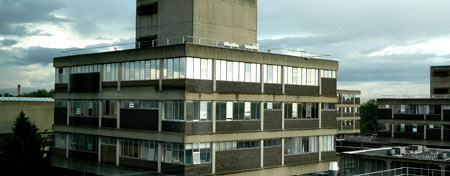
*Katyal also later cites Sommer’s Social Design for the example of airports that “prevent crime by replacing bathroom entrance doors with right-angle entrances that permit the warning sounds of crime to travel more freely and that reduce the sense of isolation”. I’d always assumed that (as with the toilet facilities in many motorway services here in the UK), this was to reduce the number of surfaces that a toilet user would have to touch – a similar strategy to having the entrance doors to public toilet areas pushable/elbowable/nudgable by users leaving the area, rather than forcing recently-washed hands to come into contact with a pull-handle which may not be especially clean. See also Sara Cantor’s thoughts on encouraging handwashing.